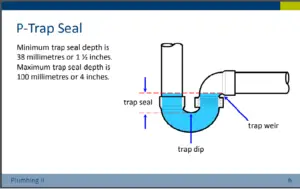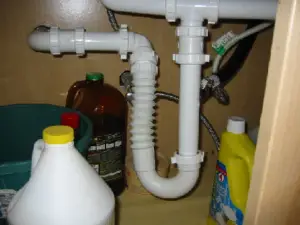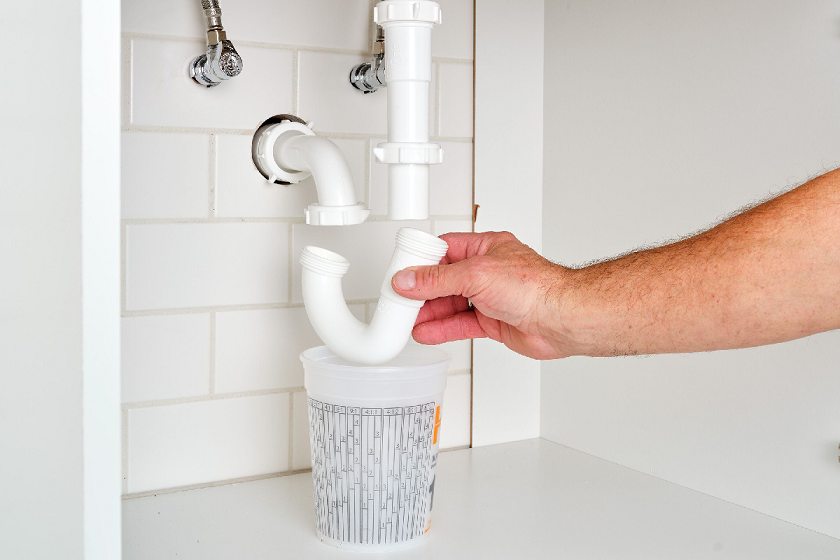P-traps come in different sizes and shapes, but proper installation is essential regardless of the kind of p-trap. It can be pretty challenging to determine how deep p-traps should be to ensure they function well when designing a house.
How deep can a p trap be? The minimum depth of a trap seal is 38 mm or 1 ½ inch, while the maximum is 100 mm or 4 inches. This depth of water is required to allow debris and wastewater move down the drain and provides sufficient force to stop sewer gases from moving up into your home.
In addition, when installing a p trap choose a height that suits you or prefer as long as it’s not over 24 inches below your drain. Importantly, your sink connection or the fixture determines the ideal place to install your p-trap. Therefore, consider this before starting the project.
What is the purpose of a p trap?

A p-trap is a u-shaped pipe designed to capture solid objects such as earrings, toys, tools, forks, rings, and food scraps.
Its main purpose is to prevent sewer gases and foul odours from traveling into your house and stinking up the place. Additionally, the gases in your sewer include carbon monoxide, methane, nitrogen, and hydrogen sulphide, which are toxic hence making a p-trap extremely useful.
A p-trap assembly typically has a tailpiece, a trap arm, a u-shaped pipe that has clean-out access, and a trap adapter connecting the tailpiece to the curved pipe.
Are there Different Types of P traps?
P-traps are available in different types, including PVC p-traps, ABS p-traps, and chrome p-traps. Knowing the types of p-traps in your home is paramount because if you decide to replace them, you must buy a similar type to ensure they are compatible with your plumbing system.
PVC p-traps are more affordable than their chrome counterparts and exceptionally tolerant to ultra-high temperature liquids and acids. Moreover, their joints are poly washers.
On the other hand, chrome p-traps are more aesthetically appealing, making them perfect for wall-mount bathroom and kitchen sinks, which are more apparent, hence should match your décor.
In addition, chrome p-traps can withstand household acids and high-temperature liquids, but they will cost you more.
Lastly, ABS p-traps are also an option. They are more robust than PVC in frigid weather, but sunlight exposure weakens them.
Read Also Can p trap be higher than drain pipe
Are there Different P-Trap Sizes?

P trap come in different sizes to suit the specific drain pipes. P-traps in kitchen and bathroom sinks, showers and bathtubs, toilets, air conditioner HV AC, and washing machine drain work similarly.
P-traps are typically made with inside diameters of 1 ½ inch for a standard kitchen sink or 1 ¼ inch for a standard bathroom sink. When it comes to length, the most common p-traps used in homes are 2 inches and 1.5 inches.
In most states, you will need to have a minimum of 2-inch washing machine p-trap for excellent draining. Furthermore, you are required to have a “soap stack” that is attached to the p-trap.
It is also called a tubular p-trap and has washers and nuts where the trap’s two parts connect, letting the trap swing sideways.
While it’s not the universal size, bathtubs are usually fitted with 2-inch p-traps.
How To Determine The Size A P-Trap
Knowing the size of the p-traps in your home may not seem like a huge deal when everything is working smoothly. However, you will want to know when you need a replacement because it needs to fit perfectly with your drain pipes.
Here’s what you will need to do to measure a p-trap:
- With a pipe wrench, unscrew the connector of the p-trap, then twist the trap.
- Wrap a measuring tape around the p-trap’s opening and write down the measurement.
P-Trap Requirements For Function And Safety
Below are the federally mandated p-trap stipulations in the United States.
- The minimum diameter for p-traps is 1.25 inches.
- P-traps can’t be installed over 24 inches (2 feet) below the drain.
- The piping between the waste line and the p-trap must have a quarter-inch slope that angles down in the direction of the drain.
- If you have a p-trap with mechanical joints, ensure they are easily accessible for maintenance.
Read Also What to do when p trap is too low
Why Should You Use A Deep P-Trap?
If your p-trap is shallow, the trap seal (the water slug that stays in the p-trap to block sewer gases from seeping into your home) will likely evaporate. This is why you should ensure your p-trap is deep enough for proper functioning.
However, it shouldn’t be too deep as well because it might make liquid flow through the trap quickly, causing trap seal siphoning and build up of sludge. This is why according to the plumbing codes, the water seal in a p-trap must be 2 to 4 inches deep.
Therefore, you will need to access the wall to move the connection of the trap arm at the drain if a sink with a deeper bowl creates an over 4 inches deep trap seal.
The assembling of these drain pieces enjoys a bit of flexibility, so after installing your p-trap, examine it to ensure you didn’t stray away from the 4 inches maximum depth.
If you are looking for a deep p-trap, we recommend EasyDrain Ref. 510 Expandable & Flexible 1-1/2” P-trap (View On Amazon). This flexible and expandable p-trap has a 1 ½ inch valve, a minimum of 13 inches and a maximum of 28 1/3 inches in length, and has four pieces
Moreover, you can easily remove it to get rid of the clog and clean it.
What Is A Deep Seal P-Trap?
Deep seal traps are plumbing pipe parts made to function with the bottom outlets in floor drains. They offer protection against odors, germs, and sewer gases.
Read Also Can p trap be lower than drain pipe
Conclusion: How deep can a p trap be?
As we have realised the maximum p trap depth is 4 inches whereas the minimum depth is 1 ½ inch inches deep and you can get one from amazon or your local hardware store.
Besides looking for a deep p trap in the market, you can also make yours if you are skilled enough. However, don’t forget to perform proper maintenance on your plumbing fixtures regularly, including your p-trap, to prolong the lifespan and optimize their performance.
Read also Can you put faucet on side of sink

